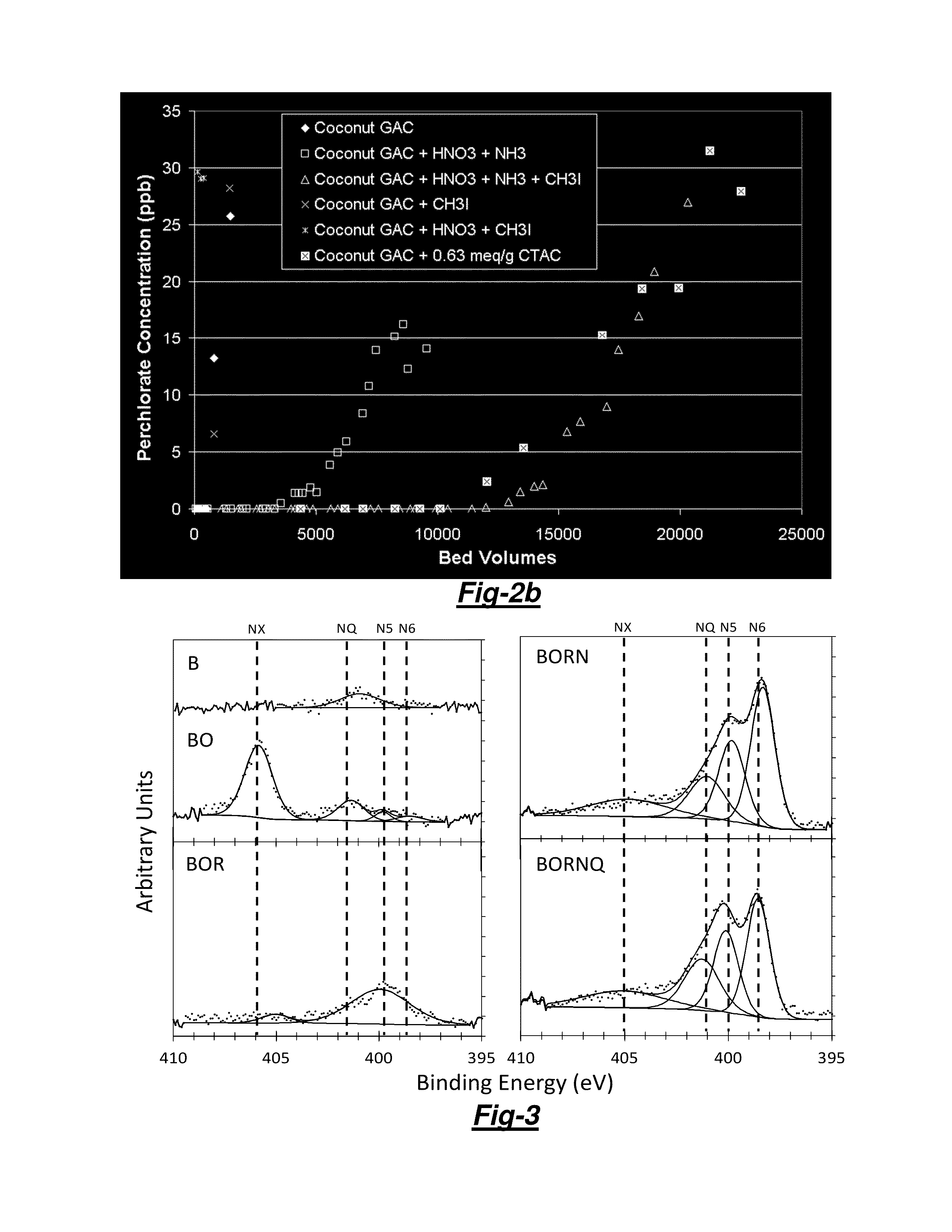Nitrogen-containing activated carbon material
a technology of activated carbon and activated carbon, which is applied in the direction of natural mineral layered products, water/sewage treatment by ion exchange, synthetic resin layered products, etc., can solve the problems of difficult removal, perchlorate has become a significant environmental contaminant, and chemical releases into surface and subsurface waters can be a pervasive environmental problem,
- Summary
- Abstract
- Description
- Claims
- Application Information
AI Technical Summary
Benefits of technology
Problems solved by technology
Method used
Image
Examples
example i
Removal of Perchlorate with Redox-Active Pyridinium Functionality or Other Nitrogen-Containing Groups
[0048]Not being bound by theory, FIG. 1 schematically illustrates a 4 step protocol for grafting a redox-active pyridinium functionality into granular activated carbon (GAC). The steps are: (1) conventional activation of the proper carbonaceous source material; (2) chemical oxidation (e.g. with HNO3 as described below) so as to create oxygen functionality along graphene edge sites; (3) thermal ammonia (NH3) treatment so as to displace oxygen (O) with nitrogen (N) and form pyridine and other N functionalities; and (4) chemical quaternization with an alkyl halide (e.g. CH3I as described below) so as to form pyridinium and other redox-active N functionalities.
[0049]Conventional activated carbons host polyaromatic graphene layers that offer reactive edge sites, and chemical oxidation with either nitric acid, hydrogen peroxide, or other oxidants can increase the materials oxygenated funct...
example 1a
Preparation of N-Tailored GACs
[0057]Four basic steps were performed to prepare or produce the N-tailored GACs, and especially the GACs that pere prepared to include pyridinium functinnality. First, one of the four pristine GACs was selected as a starting material and processed to a US Mesh #200×#400 size distribution (37-74 μm) in order to be the appropriate size for proportional diffusivity similitude in Rapid Small-Scale Column Tests (RSSCTs) that were conducted in accordance with the Standardized Proportional Mini-Column Adsorber protocol.
[0058]Second, 10 grams of the processed GAC was oxidized with 100 mL of 7.9 M Nitric Acid (HNO3). The reaction solution was stirred for 6 hours at a set temperature (20, 50, 80, 95 or 105° C.), using a condensing column to allow reflux. The residual acid was removed by filtration and the treated GAC was washed in distilled water until a constant pH was obtained. For many cases presented herein, the chemical oxidation was followed by treatment wi...
example 1b
Characterizations and Experiments
[0062]Unless otherwise specifically noted, the following characterization and experimental protocols were used throughout this patent application.
[0063]Unless otherwise specifically noted, Surface charge distribution was conducted by the Surface Charge Titration protocol reported by Chen et al. [1, 2] using a Mettler Toledo DL53 titrator (Columbus, Ohio). The total net surface charge distribution, pH of Point of Zero Charge
TABLE 1Sample naming protocol where each position represents a different step2nd Position(O or OR*)3rd Position4th PositionFull1st PositionOxidation(N or C)(Q)LabelPristine GACTemperature** (° C.)Heat TreatmentQuaternizationBOCQB = Bituminous80C: N2 gas treated atQuaternerized with(Siemens UC1240)700° C. with 30 min dwellCH3I for 5 days attime and 25 mL / min / groom temperatureflow (control)BONQN: Ammonia treated atBORNQ80*700° C. with a 30 minCONQC = Coconut95dwell time and 25(Siemens AC1240C)mL / min*g pure NH3 flowHONQH = Hardwood20(...
PUM
| Property | Measurement | Unit |
|---|---|---|
| electric potential | aaaaa | aaaaa |
| concentration | aaaaa | aaaaa |
| pore width | aaaaa | aaaaa |
Abstract
Description
Claims
Application Information
 Login to View More
Login to View More - R&D
- Intellectual Property
- Life Sciences
- Materials
- Tech Scout
- Unparalleled Data Quality
- Higher Quality Content
- 60% Fewer Hallucinations
Browse by: Latest US Patents, China's latest patents, Technical Efficacy Thesaurus, Application Domain, Technology Topic, Popular Technical Reports.
© 2025 PatSnap. All rights reserved.Legal|Privacy policy|Modern Slavery Act Transparency Statement|Sitemap|About US| Contact US: help@patsnap.com



